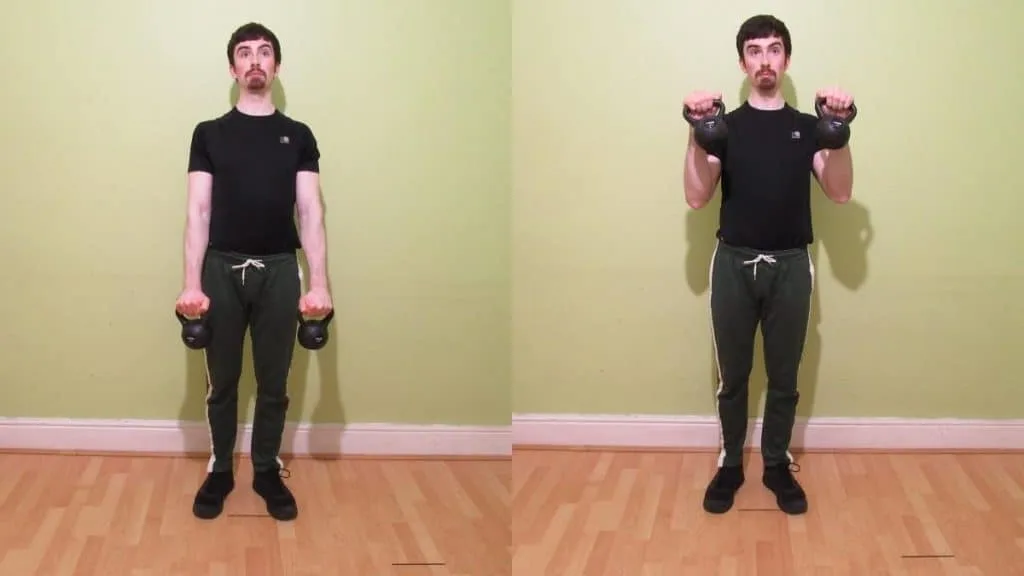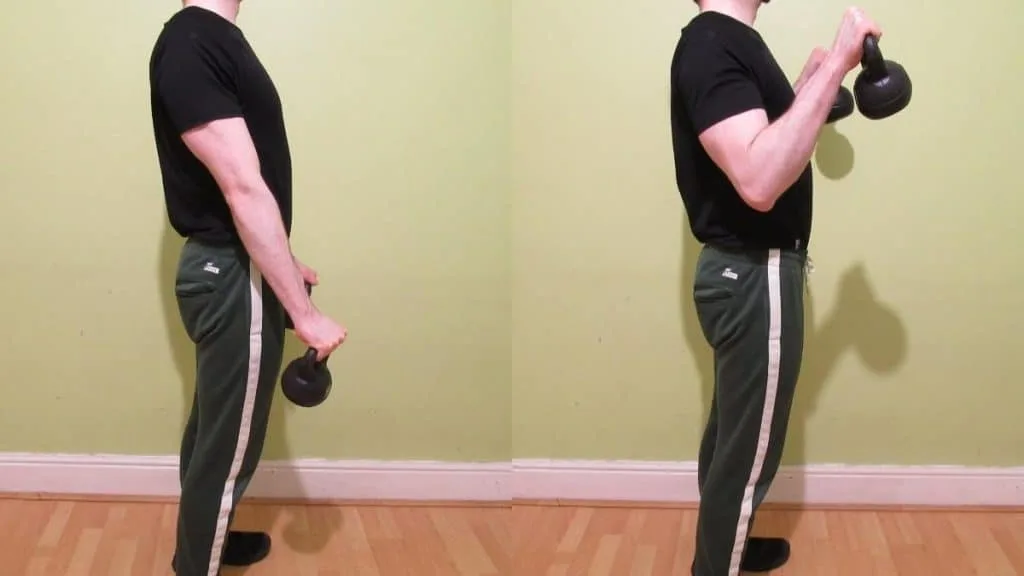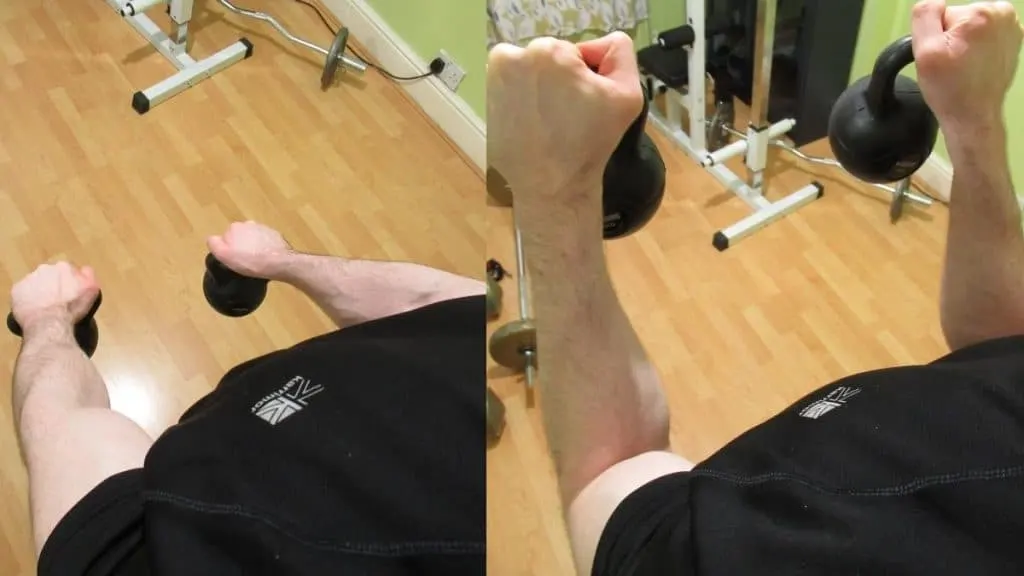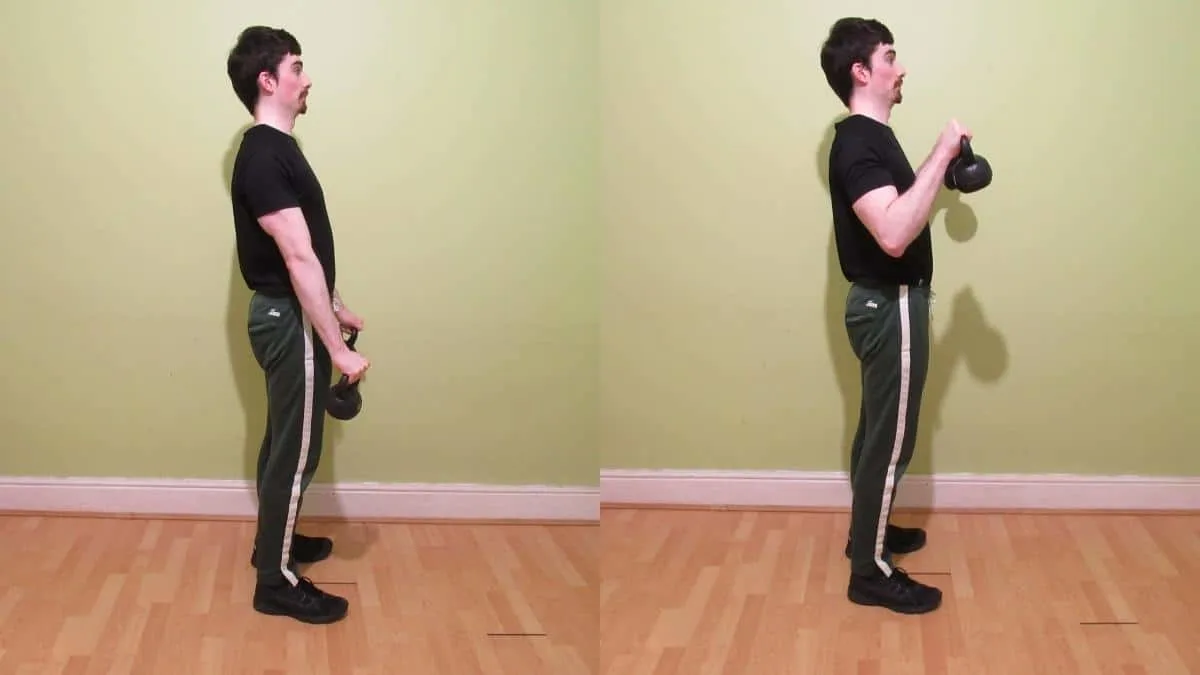Because of the biceps insertion at the radial tuberosity and the forearm fascia (via the bicipital aponeurosis), you can modify the kettlebell bicep curl to shift the tension away from your biceps and onto your brachioradialis and brachialis instead.
You do this by performing overhand curls because by using a pronated grip, you naturally put the biceps in a weak position in which they can’t produce much force. As a result, your brachialis and brachioradialis have to perform more work, which is useful considering that these two muscles are weak points for many lifters.
This guide explains how to perform kettlebell reverse curls properly and then discusses the pros and cons of the exercise.
Kettlebell reverse curl exercise details
- Also Known As: Overhand kettlebell curl, pronated kettlebell curl
- Main Muscles: Brachialis, brachioradialis, biceps brachii
- Secondary Muscles: Forearm extensors
- Exercise Type: Strength
- Exercise Mechanics: Isolation
- Difficulty Level: Beginner
- Equipment Needed: Kettlebells
How to do kettlebell reverse curls

- Hold two kettlebells by your sides with an overhand grip.
- While keeping your elbows still, curl the kettlebells toward your shoulders.
- Squeeze your arms as the tops of your forearms make contact with your biceps.
- Hold the contraction for a moment and then lower the weights under control until your elbows reach full extension.
- Perform 3-5 sets of 8-15 reps in total.
Kettlebell reverse curl advantages and disadvantages
There are many excellent bicep exercises with kettlebells that you can perform to build your arms. However, if you want to focus on your forearms as well as your upper arms, then the reverse kettlebells curl is a particularly effective option.
Advantage: Symmetrical arms

While movements like reverse EZ bar curls can indeed build muscle, they’re not the best exercises for sculpting a proportional physique. This is because your dominant arm almost always does more of the lifting than your weaker arm, which naturally leads to muscular imbalances and thus unsymmetrical arms.
Reverse kettlebells curls, on the other hand, enable you to train each arm independently so that you can provide an equal stimulus to both of your brachialis and brachioradialis muscles. This makes the exercise especially effective if you want to minimize future muscle imbalances or if you already have discrepancies in size and strength that you want to correct.
Of course, this perk is possible to achieve with other types of weights as well. So you can always read our kettlebell curls vs dumbbell curls comparison to learn which variation is right for you.
Advantage: Better forearm extensors

Unlike banded reverse curls, which, admittedly, are more convenient, kettlebell reverse curls are fantastic for developing the forearm extensors.
This is because the small muscles on the top of your forearm have to work much harder than usual to maintain a firm grip on the kettlebell.
Considering that these muscles are a weak point for many gym-goers, you can improve your physique while saving time by training your wrist extensors in addition to your brachioradialis and brachialis.
The only problem is that your forearms might give out first if they’re particularly weak in comparison with your upper arms, which would obviously mean that the other target muscles wouldn’t receive a sufficient workout.
Disadvantage: Hard to progress

We’ve said this many times. As good as kettlebells are, training with them frequently, especially for a small body part like the arms, isn’t always feasible in some fitness facilities. This is because not all gyms have kettlebells that ascend in manageable increments.
This means that you often have to make considerable weight jumps in order to progress to the next kettlebell. As mentioned, this is very challenging and sometimes impossible to do when you’re training small muscle groups.
So if your gym doesn’t have a good selection of kettlebells, then you might be better off sticking with exercises like the reverse TRX curl that don’t require much equipment to give you a great workout.
Conclusion: Are kettlebell reverse curls worth doing?

Kettlebell reverse curls are a highly effective muscle-building movement because they enable you to train each arm independently. This, in turn, helps you to achieve a well-balanced body because you can ensure that both sets of arm muscles are receiving equal work.
It’s also a helpful exercise to do at home because, like kettlebell crush curls, it doesn’t require much space.
The only downside is that it’s not a great exercise for gaining strength rapidly unless you have plenty of kettlebells at your disposal. That said, the kettlebells reverse curl is still valuable as an auxiliary exercise to finish off your arms after a heavy workout.

